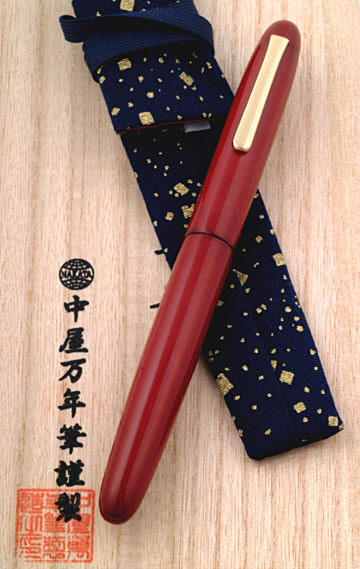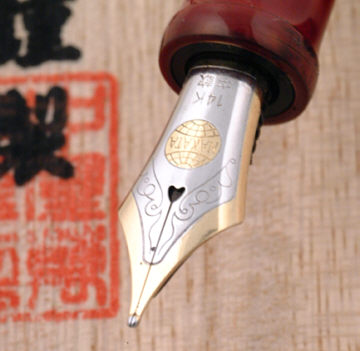|
Lacquerware is a craft that has been
practiced in Japan for centuries. Japanese lacquer is made from the sap of the
Urushi tree. Japanese Urushi craftsmen have been making it and applying it to
bowls, boxes and other objects to create products of singular beauty for ages.
And, thankfully, the Nakaya Pen Co. of Japan also uses Urushi lacquer to produce
fountain pens of singular beauty.
 The
pen you see pictured is called Wajima-Nuri Shu. Its cap and barrel are turned
from ebonite and then the Urushi lacquer is applied. Wajima is a Japanese city
well known as one of the centers of the Urushi craft and Shu represents the color
of the lacquer itself-a deep maroon. The
pen you see pictured is called Wajima-Nuri Shu. Its cap and barrel are turned
from ebonite and then the Urushi lacquer is applied. Wajima is a Japanese city
well known as one of the centers of the Urushi craft and Shu represents the color
of the lacquer itself-a deep maroon.
I ordered this pen without understanding
its prodigious size. It is fully 6 1/2" long capped. It fairly dwarfs a
Pelikan 1000 when set along side it. This pen is normally not made with a pocket
clip because it is not intended to be carried but rather to be used at a desk
and to reside in a pen stand. Unknowingly, I asked Nakaya to to add a pocket
clip and they complied. I doubt I have a pocket deep enough to actually engage
the clip so it is residing currently on my pen stand, clip and all, as it should
be.
Also note that the pen is not designed
to be used with the cap posted. It is insanely long that way and plenty long
without the cap. Since it is designed to be a desk pen rather than a portable
pen, it all makes sense. Nakaya makes pens designed for portability as well
so you can have that if you like. As an example, I own a modestly sized and
beautiful tortoise celluloid Nakaya that I have written about previously on
Pentrace and that you can read about by clicking
here.
Looking at the lacquer finish on
this pen is like looking into a dark red pool. The finish is deep and lustrous
and incredibly smooth to the touch. It is a pleasure to use, both for its tribute
to the senses but, more importantly, because it will write better than any other
pen. Why? Because It is custom made specifically for its owner's writing style.
This pen is made for me and the way I write.
The Nakaya brochure is titled "For
your hand only" and it is appropriate since every Nakaya pen is custom
made specifically for a single customer. The customer can select a finish and
color among the several cap and barrel designs and even request a pocket clip
where one might be inappropriate. But more importantly, the nib is ground specifically
for the owner's personal writing ergonomics. To complete an order, Nakaya needs
to know a number of details about how the customer writes. The web site has
the customer answer a number of questions about personal writing habits and
ergonomics. You need to describe how you hold the pen, how much pressure you
apply to your writing and a number of other points that go into the formula
the craftsmen use in the grinding of the nib. It is a fairly simple process
for the customer. I did it for my first Nakaya by sitting at the computer, pen
in hand, and simply comparing what I saw in my hand to the images on the Nakaya
web site. It was easy and effective. Once my ergonomics were on file at Nakaya,
I was able to order this second pen easily by email.
 Nakaya
provides two nib options. Both are 14K gold nibs. A single tone gold nib is available
in Japanese super extra fine to extra broad stub. In other words, you can have
any size nib you like. The second nib is a two tone nib which, unlike the standard
nib, is also available in "soft and flexible" medium. That is the nib
I ordered and the one pictured here. The two tone nib costs an extra $80. Nakaya
provides two nib options. Both are 14K gold nibs. A single tone gold nib is available
in Japanese super extra fine to extra broad stub. In other words, you can have
any size nib you like. The second nib is a two tone nib which, unlike the standard
nib, is also available in "soft and flexible" medium. That is the nib
I ordered and the one pictured here. The two tone nib costs an extra $80.
No, it isn't like the springy flexible
nibs you might encounter on some vintage pens, but it has enough flex to provide
good line variation to your writing. Apply light pressure and the line looks
like a Japanese medium or Western fine. Apply a little pressure and the line
broadens. Apply more and the line broadens even more. For those familiar with
the Namiki Falcon, this pen is somewhat more flexible and provides a little
more line variation with a little less pressure. It is in the same ball park,
however. Overall, this nib is in a totally different class than that of the
Namiki Falcon so perhaps the comparison is a little unfair.
Personally, I don't care for the
very flexible vintage nibs. I find them fussy and hard to use and I generally
prefer stiffer modern nibs. However, I had no problem adjusting to the Nakaya
soft nib. I normally apply virtually no pressure with a fountain pen and this
nib behaves like most modern nibs so I don't even notice the flexibility. When
I bear down a little, though, the nib responds instantly to broaden the line.
It is really a pleasure for me to use and fun.
Nakaya nibs aren't polished so smoothly
that you can't feel them on the paper. They have just a little "tooth"
that provides a nice, comfortable sensation as one writes. Both of my Nakayas
behave the same way except that I have the soft flexible nib only on this Wajima-nuri
shu. And my, how they write! You simply haven't experienced the pinnacle of
fountain pen writing until you have used a nib ground to your specific ergonomics
and then adjusted for perfect flow and performance. It is a unique sensation
and one that can be provided only by Nakaya or by one of the custom "nibmeisters"
who do aftermarket custom nib grinding. These pens simply work wonderfully and,
for me, that is their most important characteristic.
Some modern nibs are so poorly designed
that they must be sent to a "nibmeister" to be made useable. Sometimes
this can only be accomplished by increasing the flow of the nib until it runs
like a virtual river. The Nakaya nib feeds absolutely perfectly. It lays down
exactly the right amount of ink - not dry, not wet. It responds the instant
the nib touches paper and never, ever skips. I've left my tortoise celluloid
on the pen stand for over two weeks and marvelled that it started instantly
when I picked it up and wrote with it. I haven't owned this particular pen that
long but I'm confident it will prove to perform as perfectly as my first one.
When I write with it, it feels exactly like the celluloid except, of course,
that the barrel is larger and the nib has some flexibility.
The cost of this pen was $460 with
an additional $80 for the upgraded nib. It feeds from a Platinum cartridge or
converter. It is shipped in an attractive wooden box and includes a dark blue
fabric pouch, a converter and package of black ink cartridges. The box and pouch
are used as props in the photograph at the top of this article. My celluloid
arrived a couple of weeks after my order. The Wajima-nuri shu took about a month,
presumably because of the lacquer work. The pen arrives already inked and tested.
There is no need to do anything before starting to write with it. The Wajima-nuri
shu started instantly after having made the trip from Japan by mail. I'm confident
that it will continue to perform the same way into the future.
If my enthusiasm for Nakaya pens is obvious then it is for good reason. I consider
them the best writing fountain pens available. Couple this with attractive syling
and you have a winning combination. Click
here to visit the Nakaya web site. Happy writing.

|